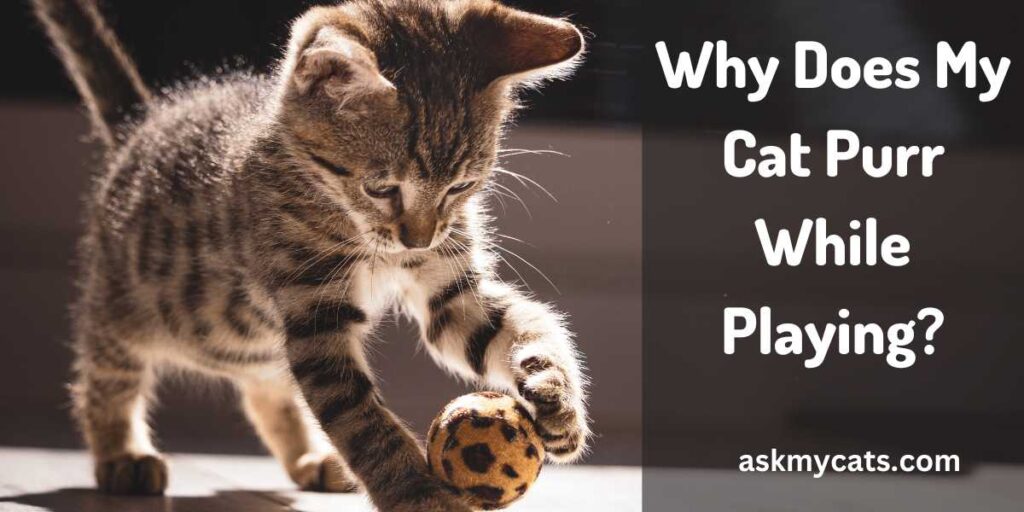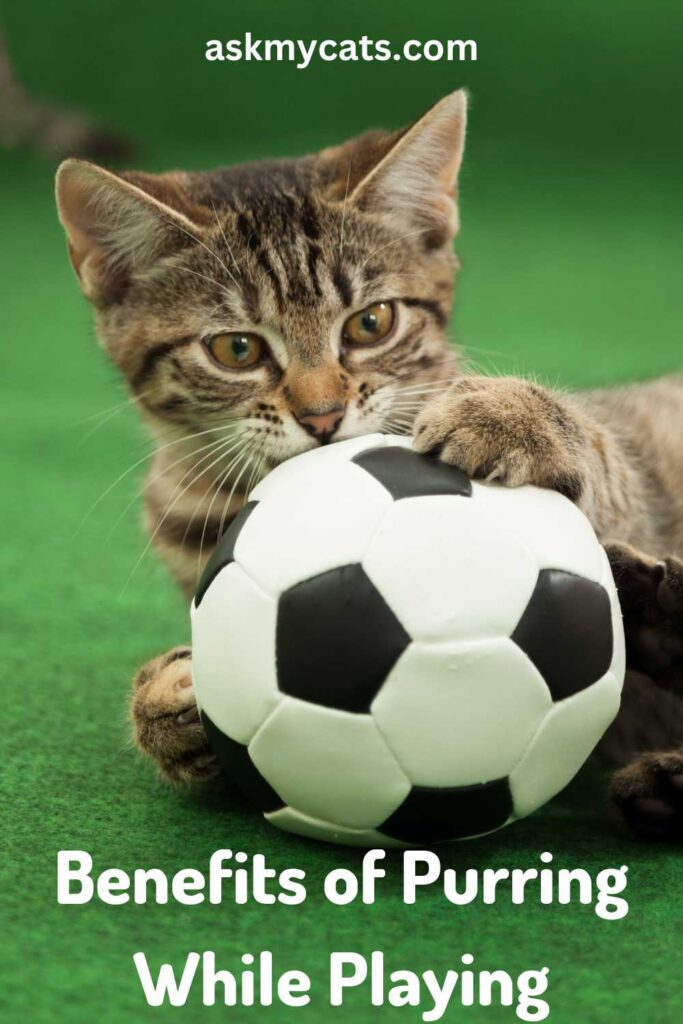You are probably acquainted with the fact that cats purr most often when they are at their happiest and are floating on clouds of bliss. So it shouldn’t come as a surprise that cats also purr when they are playing with their balls of wool or chasing down imaginary mice across the hallway.
Playing is obviously fun for cats, and that makes them purr joyfully.
Read the rest of the article to know more about the benefits and risks of a cat purring while playing.
Key Takeaways
- Cats purr when they are happy and content, and this includes when they are playing.
- Purring is a way for cats to communicate with their caregivers, and it reflects social pleasure and contentment.
- Cats can purr during playtime for different reasons, and it is quite common for them to do so.
- Cats associate playing with positive interactions and experiences, which could explain why they purr while playing with their favorite toys.


Give Your Cat the Perfect Day
Get the Free Ebook!
Do Cats Purr When They Play?
Yes, cats most definitely purr while playing. However, not all cats do so. A cat’s purring is most noticeable when she is being petted or stroked by her owner or even when nursing her younger one.

Thus, naturally, it is assumed that a cat’s purring is an expression of her joy and satisfaction. But, in actuality, a cat also purrs in times of stress or trepidation such as during an injury or a visit to the vet.
Earlier, it was believed that purring was a result of the blood surging through the inferior vena cava or produced by a separate voice box. However, recent research advocates that the internal laryngeal muscles are the probable source. This is proven by the fact that there is an absence of purring in cats with laryngeal paralysis.
Research suggests that the vocal cords in a cat’s throat vibrate due to the muscles present and as the cat inhales and exhales, the air hits these vibrating muscles, emanating the purring sound.
The Library Of Congress explains it as follows “The laryngeal muscles are responsible for the opening and closing of the glottis (space between the vocal cords), which results in a separation of the vocal cords, and thus the purring sound.”
A cat purrs to communicate with her close ones and it is generally a sign of positive social situations: grooming, nursing, petting, etc. It is also a reflection of self-soothing behaviors. A cat’s purr is said to have healing properties.
Hence, cats purr while playing to express their feelings of joy and happiness.
Interesting Read: Why Does My Cat Purr When He Sees Me?
Is It Normal For My Cat To Purr While Playing?
Yes, it is perfectly common and normal for cats to purr while playing. Just like meowing, purring is also a way for cats to communicate. Cats start purring when they are just a mere few days old.
They do this before they even learn how to meow to catch the attention of their mother for nursing and feeding. This vocal characteristic of purring is carried well into adulthood and cats purr to communicate with their human parents.
Usually, it is assumed that cats purr only when they are happy or experiencing positive emotions. However, a cat’s purring has a plethora of different connotations and cannot be associated with a single emotion.
As Tony Buffington, a cat expert, and veterinarian at Ohio University rightly says
“It’s naive to think that cats can only purr for one reason—it’s like thinking that people can only laugh for one reason.”
Hence, cats can be purring during playing for numerous different reasons and it is quite commonplace for them to do so.
Interesting Read: Is Purring Involuntary In Cats?
Why Is My Cat Purring While Playing?
It is safe to say that playing is one of the favorite past times for cats. They love playing, be it amongst themselves or with their human caregivers.
It is also pivotal for their mental and physical stimulation. Purring is a form of vocalization that often reflects social pleasure and contentment.
Hence, if a cat purrs during playtime, it is plausible that she is expressing joy.
1. Your Cat is happy
The most common reason behind your cat’s purring could be that she is happy. A cat can be seen purring when she is being petted or stroked by her owner.
Cats also associate playing with positive interactions and experiences. So they could be purring while playing with their favorite toy as they feel energetic and exuberant.
Generally, younger cats are more active and playful than older ones. Cats gravitate towards sudden and rapid movements, as they are more excitable in nature.
2. To Communicate with you
Purring can be a way for cats to communicate with their caregivers, like if they want food. This attention-craving purring tends to be more high-pitched and urgent than the others.
‘Insider’ explains “According to researchers, humans are more likely to react to this type of urgent, solicitation purr. A 2009 study conducted playbacks of purrs from 10 cats recorded in both solicitation contexts with cries accompanying the purrs and in non-solicitation contexts. The 50 human participants regarded the solicitation purrs as more urgent and less pleasant.”
Hence, your cat could be purring to catch your attention and to invite you to play with her.

3. They are hurt
While playing is decidedly fun, it is not free from risks and accidents. My little furball gets very jumpy during playtime and is definitely accident-prone.
Cats don’t just purr when they are happy, but they also purr to express negative emotions like pain, fear, or stress. If your cat gets hurt while playing, she will purr to call out to you.
4. Healing
When cats purr, they release a hormone called endorphin in their blood vessels. This chemical is a happy hormone that makes one feel social, joyous, and excited.
Endorphin is also the hormone that is released within us after physical exercise.
Research has found out that cats do not only release endorphins in their own body, but it also permeates humans.
The catch here is the purring sound. For decades healers have believed that certain vibrational sounds promote mental and physical healing in humans. Studies have depicted that a cat also purrs at the same frequencies that the healers have been using.
According to Mom.com “Cats are able to heal because their purrs fluctuate between 20 to 140 Hz, a frequency range which has been proven to be medically therapeutic.”
Hence, if your cat gets hurt while playing, she will purr in order to heal herself and alleviate some of the pain.
Interesting Read: Why Is My Cat Purring So Much Constantly?
Types of Toys That Might Make Cats Purr More Often
| Type of Toy | Explanation |
|---|---|
| Interactive Toys | Interactive toys that allow cats to engage in hunting and chasing behaviors can be particularly stimulating and may elicit purring. |
| Catnip Toys | Many cats respond to catnip with excitement and playfulness, which can lead to purring. |
| Soft Toys | Soft toys that can be cuddled or wrestled with may provide cats with comfort and security, leading to purring. |
| Laser Pointers | Some cats love chasing laser pointers, which can be a fun and stimulating form of play that might elicit purring. |
Benefits of Purring While Playing
Playing is not just fruitful for your cats. When your cat purrs while playing, it is also very beneficial for you. Let’s find out how:

1. Improved Physical Well-Being
As we all know, exercise and play are great ways to promote one’s well-being. The physical exertion that comes with play will go a long way in improving your cat’s health and physical stamina. It ensures a steady blood flow, enhanced functioning of the lungs and heart, and greater dexterity.
2. Improves Mental Well-being
Playing does not just promote physical health, but it also enhances mental well-being. Physical exercise releases a hormone called ‘endorphin’ which is also called the happy hormone. Endorphin is a great stress buster and alleviates mental fears and anxiety in cats.
3. Bonding
Playing with your cat will be extremely beneficial for your relationship with her. She will learn to see you as her playmate and friend, and this will build a bond of trust and understanding between you and your cat.
Interesting Read: Why Does My Cat Purr So Loudly?
Potential Risks of Playing While Purring
While playing is definitely advantageous for cats, it does not come without certain caveats.
As with everything, there is a balance that has to be maintained with playing. Too much or too little can cause more harm than good.
1. Overstimulation
An excess of physical exertion for hours on end can lead to a degradation in health. Thus, ensure that the duration of your cat’s playtime should be optimal, ranging from 30-45 mins.
2. Potential Injury
If not careful, vigorous playing could also lead to injury, not only for your cat but also to you. Hence, precautions must be taken to prevent any injury.
Frequently Asked Questions
Do all cats purr?
No, purring is only found in domestic and some species of wild cats. Cats that don’t purr, roar, and those that can’t roar, purr. This is because, in roaring cats, there is a small bone inside the vocal cords that is a flexible ligament. This stretchable ligament allows big cats to make a deep sound but in domestic cats, the flexibility of the ligament is replaced with a hardened bone. Therefore, all cats cannot purr.
Do cats control their purring?
While meowing is a definitive action, purring is an involuntary one, done almost unconsciously. Cats purr to reflect their feelings, whether joy, stress, or fear. Cats cannot control their purrs, it is nearly reflexive.
Final Thoughts
Cats purr to express their feelings, not just positive ones like joy and satisfaction, but also negative ones such as pain, anxiety, and fear. Playing is very beneficial for cats as it is mentally and physically stimulating.
Hence, while playing, cats often purr to press their contentment and happiness. They could also be purring because they got hurt and purring can alleviate their pain.
